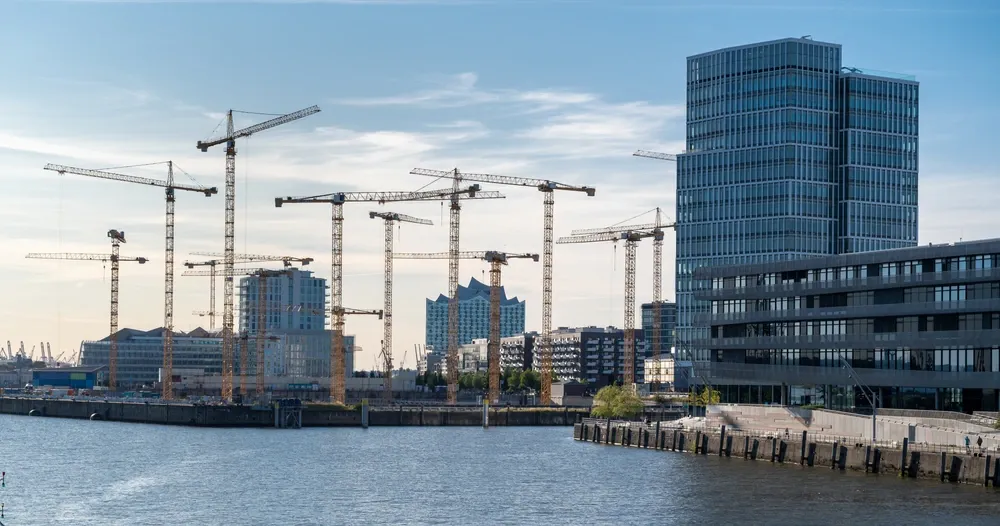Upstox Originals
Beyond destruction: How German engineering rebuilt a nation

5 min read | Updated on May 09, 2025, 20:24 IST
SUMMARY
Germany’s bounce back from the devastation of World War II is an incredible story of engineering in action. From fixing the most basic things to reimagining whole cities and rebuilding industries, German engineers showed amazing skill and determination.

Construction site in the district Hafencity of Hamburg, Germany. | Image: Shutterstock
Think about some of the coolest inventions we use daily – the car, the diesel engine, even keeping our food cold in the fridge. Guess what? Germany was a hotbed of innovations a long time back. Men like Carl Benz, Rudolf Diesel, and Carl von Linde laid the groundwork for much of it. But it was after the nightmare of World War II that Germany's real engineering muscle truly showed itself – it had to rebuild a whole country that was practically in ruins.
How severe was the damage?
Imagine your city, or even your neighborhood, looking like it had been through a massive storm, but much worse. That's what most parts of Germany were like after the war. A survey by the US military looked at 49 of the biggest German cities, and almost 40% of all the homes were either gone or seriously ruined. Just one bombing in Dresden in 1945 wiped out around 75,000 homes.
It wasn't just houses, though. Factories were also hit hard – about 20% of Germany's industrial power was gone.
Even getting around was a nightmare. Trains, trucks and boats were either destroyed or taken away. Even the famous Autobahn highways weren't spared. Cities were reduced to piles of rubble. By 1947, Germany was producing only a third of what it was before the war. Talk about starting from scratch.
Rebuilding a nation, step by step
The recovery wasn't quick or easy. It was a gradual process, and it was driven by that strong German knack for engineering – a way of thinking that's all about solving problems and building things right.
First things first, they had to get the basics working again. Civil engineers got to work checking out all the damage and figuring out how to fix or rebuild it, sometimes just temporarily to get things moving.
Then there were the mechanical and electrical engineers. They were the ones who tackled the power plants, water systems, and phone lines. Often, they had to use whatever bits and pieces they could find to get things going again, coming up with clever, quick solutions. Regular engineers were even figuring out how to fix train tracks and bridges when they didn't have a lot of materials.
Architects and structural engineers had the big task of making bombed-out buildings livable and getting factories running again. This meant clearing tons of rubble, making shaky buildings safe, and doing basic repairs just to get started.
Revival of urban planning and housing: Reimagining cities
As they started to get back on their feet, they had to think bigger – how to rebuild whole cities. Places like Cologne and Frankfurt were carefully replanned and rebuilt from the ground up. This is where people like Ernst May came in.
May was already known for his innovative ideas about social housing before the war. After the war, his work became even more important. He wasn't just designing individual houses; he was thinking about how people would live together, designing whole neighborhoods. He believed in modern ideas – clean, simple buildings that worked well and had green spaces around them. This was a fresh start, leaving behind the old, fancy styles. May pushed for using things that could be made in factories and put together quickly. This sped things up. The way many German cities look today still shows the impact of these ideas.
Getting back on the road
Even though German factories were smashed, the country’s car industry had that engineering know-how deep down. Slowly but surely, using whatever they had left, they started making cars again. At first, it was about simple, affordable transportation, like the famous Volkswagen Beetle. As things got better, companies like Mercedes-Benz and BMW started to come back, too. They might have started with older designs, but soon they were building new cars with all sorts of advanced engineering. This comeback is a big reason why Germany is still known for its world-class cars today.
One person who stands out in this story is Ferdinand Porsche Jr., or Ferry Porsche. He took the basic idea of a "people's car" and, with his team, engineered something incredible: the Porsche 356. He wanted a sports car that drove well and was built with smart design. Even though times were tough, the Porsche 356 was a hit and made the Porsche name famous for high-performance cars. Ferry, leading his engineers in a country still scarred by war, turned a simple concept into a dream car.
Connecting the nation again
Think about how important bridges are for getting around. Well, World War II destroyed several of them in Germany, cutting off vital connections. That's where civil engineers like Karl Schaechterle stepped in. He specialised in bridges and was key in figuring out how to fix or replace them quickly, sometimes with temporary solutions just to get traffic flowing again. He and other bridge engineers were masters at finding smart ways to rebuild, often using whatever materials they could find. Getting those transportation links back up and running was huge for Germany's recovery.
In short, the way Germany bounced back from the devastation of World War II is an incredible story of engineering in action. From fixing the most basic things to reimagining whole cities and rebuilding industries, German engineers showed amazing skill and determination. Even when everything seemed broken, their focus on smart design, efficiency, and looking towards the future not only rebuilt a country but also cemented Germany's place as a world leader in engineering. The spirit of building and problem-solving proved to be a powerful force for a new beginning.
By signing up you agree to Upstox’s Terms & Conditions
About The Author
Next Story
